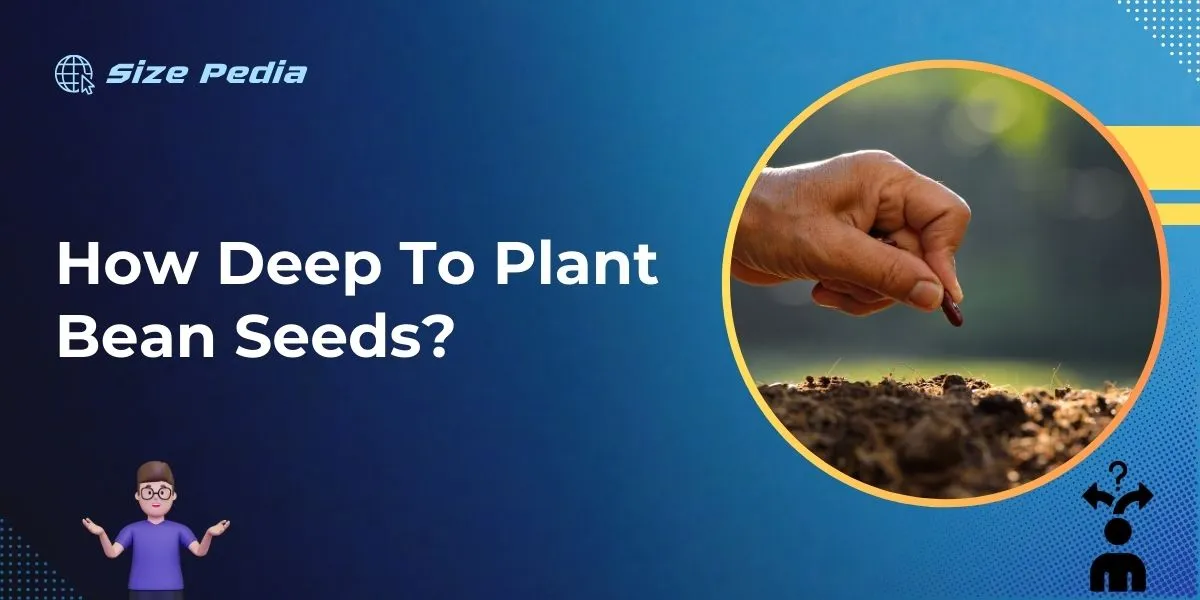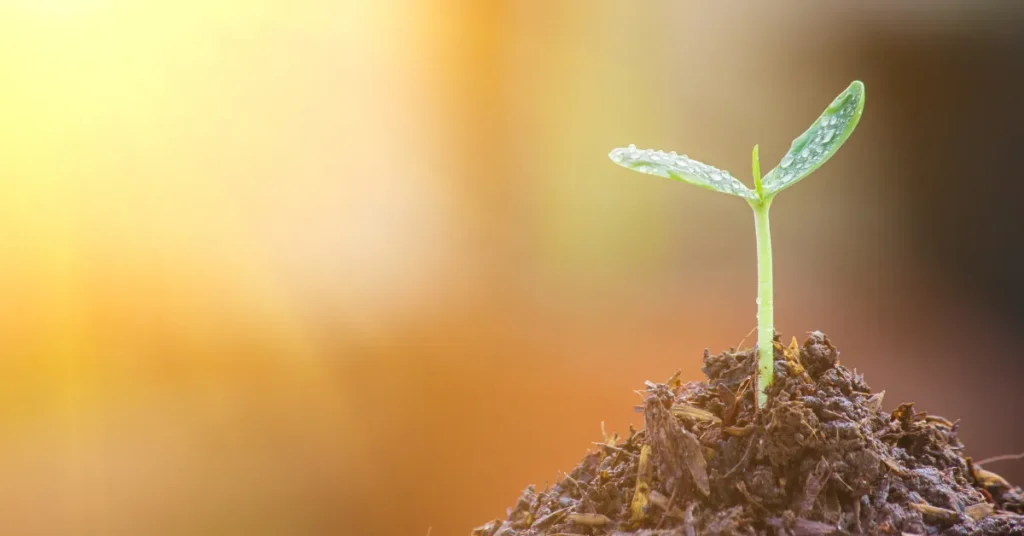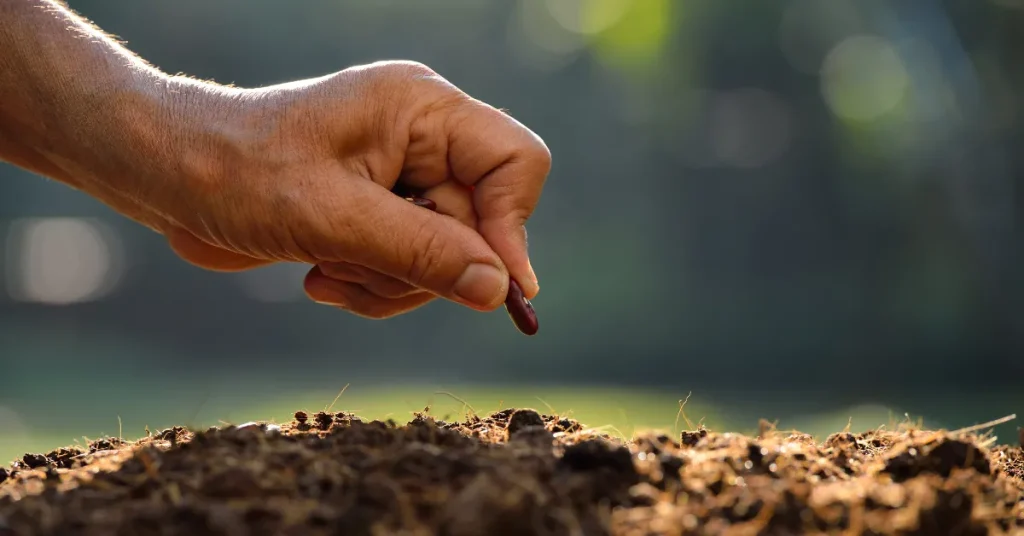Bean seeds should be planted 1 to 1.5 inches deep in the soil. Ensure spacing is about 2-4 inches apart.
Planting bean seeds correctly helps maximize yields and promote healthy growth. Depth plays a critical role in seed germination; too shallow can lead to drying out, while too deep can hinder or prevent sprouting.
Soil temperature is also crucial; ideally, it should be between 70-90°F for optimal germination.
Proper planting depth ensures the seeds have sufficient moisture and warmth to germinate successfully.
Consistency in planting depth across your garden will contribute to more uniform growth and development of your bean plants, leading to an abundant and healthy harvest.

Digging Into The Basics Of Bean Planting
Welcome to the essential guide on ‘Digging into the Basics of Bean Planting’. Growing beans is both fun and rewarding. Before you start, understanding the planting basics is key.
This includes knowing your bean variety and the right depth to plant your seeds. Let’s delve into these core principles and set the foundation for a bountiful bean harvest.
Bean Varieties And Their Growth Requirements
Beans come in many shapes and sizes. Each type has unique needs to thrive. The common bean family splits into two main groups:
- Bush beans – Compact and do not need support
- Pole beans – Require a trellis or stakes to climb
Consider climate, space, and support when choosing your variety. Certain beans prefer cooler temperatures, while others love the heat. Soil quality and sunlight also play crucial roles in their growth.
| Bean Type | Sunlight | Soil Temperature | Support Needed |
| Bush Beans | Full Sun | 60-70°F | No |
| Pole Beans | Full Sun | 65-75°F | Yes |
The Importance Of Seed Depth
Planting depth is crucial for beans. If too shallow, birds may eat them. If too deep, beans might not sprout. A general rule for beans is to plant them about 1 to 2 inches deep. This depth provides optimal conditions for germination.
- Make a hole at the right depth.
- Place the seed inside carefully.
- Cover it with soil without compacting too hard.
Always keep the soil moist but not waterlogged. Consistent moisture helps in germination.
Soil Preparation For Optimal Bean Growth
Soil Preparation for Optimal Bean Growth sets the stage for a bountiful harvest. Just like building a house needs a solid foundation, planting beans requires preparing the ground upon which they will flourish.
Think of it as creating a cozy bed for bean seeds to snuggle in, ensuring they wake up in an environment that’s just right for growth. Let’s dive into the essentials of soil prep for those eager-to-grow beans!
Creating The Perfect Soil Texture
Textured soil that’s just right plays a huge role in growing happy beans. Beans love soil that’s fluffy like a pillow, not too tight, so their roots can breathe and wander freely. Here’s the scoop on crafting that ideal soil bed:
- Loosen the soil up to a depth of about 8-10 inches. This allows roots to move easily.
- Add organic matter like compost or aged manure to improve soil health.
- Ensure drainage is on point. Beans don’t like wet feet, so keep the soil cozy but not soggy.
- Smooth out the soil surface so seeds can make firm contact and soak up moisture evenly.
Ensuring Proper Nutrient Balance
Beans thrive when the soil is just as rich in nutrients as their favorite beanstalk fairy tales. Strike the right balance and watch them climb high.
| Nutrient | Importance | How to Add |
| Nitrogen | For green growth | Beans fix their own, but a starter helps |
| Phosphorus | For strong roots | Bone meal or rock phosphate |
| Potassium | For overall vigor | Wood ash or greensand |
Don’t overfeed; beans are quite frugal. Test the soil to see what it needs before diving in with nutrients.
The Science Behind Seed Depth

Understanding how deep to plant bean seeds is crucial for a bountiful harvest.
It affects how seeds absorb water and nutrients. It also influences their ability to breakthrough to the surface.
Germination Process Explained
Germination is a seed’s awakening from dormancy. Inside their hard shell,
seeds are alive but inactive until they receive the right moisture and temperature.
- Water activates enzymes
- Enzymes fuel the seed’s growth
- The root pushes downward
- The shoot makes its way up
How Depth Affects Seedling Development
Planting seeds at the correct depth ensures optimal growth conditions. Too shallow planting may lead to
poor root development. Too deep can exhaust the seed’s energy before it reaches sunlight.
| Depth | Effect on Seedling |
| Too Shallow | Dries out quickly, poor root foundation |
| Optimal Depth | Stable moisture, good root and shoot development |
| Too Deep | May not reach the surface, stunted growth |
Hands-on Guidance For Planting
Welcome to our hands-on guide for planting bean seeds! Whether you are a beginner or an experienced gardener, this guide will walk you through the steps to ensure your beans thrive from the get-go.
Proper depth and spacing are crucial for bean cultivation. Let’s dig into the process that promises a bountiful harvest.
Step-by-step Planting Technique
- Choose a sunny spot with well-drained soil for your beans.
- Prepare the soil by loosening with a garden fork, removing any weeds.
- Mark a row with a string line to keep your seeds straight.
- Use your finger or a stick to make a hole about an inch deep.
- Drop in two bean seeds per hole to ensure germination.
- Cover gently with soil, don’t press down hard on the seeds.
- Water the row lightly to moisten the soil without causing erosion.
Tips For Consistent Seed Spacing
- Use a ruler for perfect spacing; beans need 2-4 inches between them.
- For rows, keep 18-24 inches apart to let sunlight reach every plant.
- Make a dibber with marked measurements for even seed placement.
- Consider a seed planter if you’re planting a large area.
- Plant a few extra seeds at the end of rows as a backup.
Post-planting Care For Bean Seeds
After planting your bean seeds at the perfect depth, caring for them properly is crucial for a bountiful harvest.
Post-planting care involves the right balance of water, nutrition, and attention to ensure your bean plants thrive. Let’s dive into some essential tips to keep your beans growing strong.
Watering Dos And Don’ts
- Keep soil moist, but not waterlogged.
- Water at the base of the plants to avoid wetting the foliage.
- During germination, ensure consistent moisture levels.
- Avoid overhead watering to minimize disease risk.
- Once established, reduce frequency but increase depth of watering to encourage deep root growth.
When And How To Fertilize
| Timing | Type of Fertilizer | Application Method |
| After first true leaves appear | Low-nitrogen, phosphorus-rich formula | Side-dress alongside plants |
| Flowering and pod formation | Balanced, slow-release blend | Gently work into soil away from roots |
Use compost to add nutrients without over-fertilizing. Never apply fertilizer to dry soil; water plants thoroughly after feeding to prevent burn.
Troubleshooting Common Bean Plant Problems

Welcome to our guide on troubleshooting common bean plant problems. Growing beans can be simple and rewarding. Yet gardeners may face issues that affect their crop. Understanding these issues is key to a healthy harvest.
Dealing With Poor Germination
Poor germination can frustrate many gardeners. Here’s how to handle it:
- Check Seed Quality: Old or low-quality seeds may not germinate well.
- Soil Temperature: Beans need warm soil. Ensure the temperature is between 70-90°F.
- Planting Depth: Plant seeds 1-1.5 inches deep. Deeper planting may hinder sprouting.
- Watering: Keep the soil moist. Water gently to avoid washing away seeds.
Guarding Against Pests And Diseases
Beans can attract pests and succumb to diseases. Follow these tips to protect them:
| Problem | Solution |
| Bean Beetles: | Inspect regularly. Pick off beetles. Use insecticidal soap if necessary. |
| Fungal Diseases: | Water at the base. Avoid wetting foliage. Promote air circulation. |
| Root Rot: | Ensure good drainage. Don’t overwater. Use compost to enrich soil. |
FAQs About How Deep To Plant Bean Seeds
How Deep Should You Plant Bean Seeds?
Bean seeds should be planted about 1-2 inches deep in the soil. This depth provides the seeds with adequate soil coverage for moisture retention and allows for sufficient space to root and emerge as seedlings.
What’s The Ideal Spacing For Planting Bean Seeds?
Bean seeds should be spaced about 2-4 inches apart in rows. Rows should generally be spaced about 18-24 inches apart. Proper spacing ensures ample room for growth and air circulation.
Do Bean Seeds Require Full Sunlight To Grow?
Yes, bean seeds require full sunlight to grow effectively. They thrive best with at least 6-8 hours of direct sunlight daily to ensure healthy growth and optimal bean production.
How Long Does It Take For Bean Seeds To Germinate?
Bean seeds typically germinate within 8-10 days, given the right conditions. Adequate warmth, moisture, and soil quality can influence the speed of germination.
Conclusion
To sum up, mastering bean seed planting depth is crucial for a thriving garden. Aim for an inch beneath the soil’s surface.
Remember, consistency and proper depth encourage uniform growth and healthy bean plants. Ready your garden, plant those seeds right, and watch as your beans reach for the sky!
Resources:
1. https://extension.umn.edu/vegetables/growing-beans
